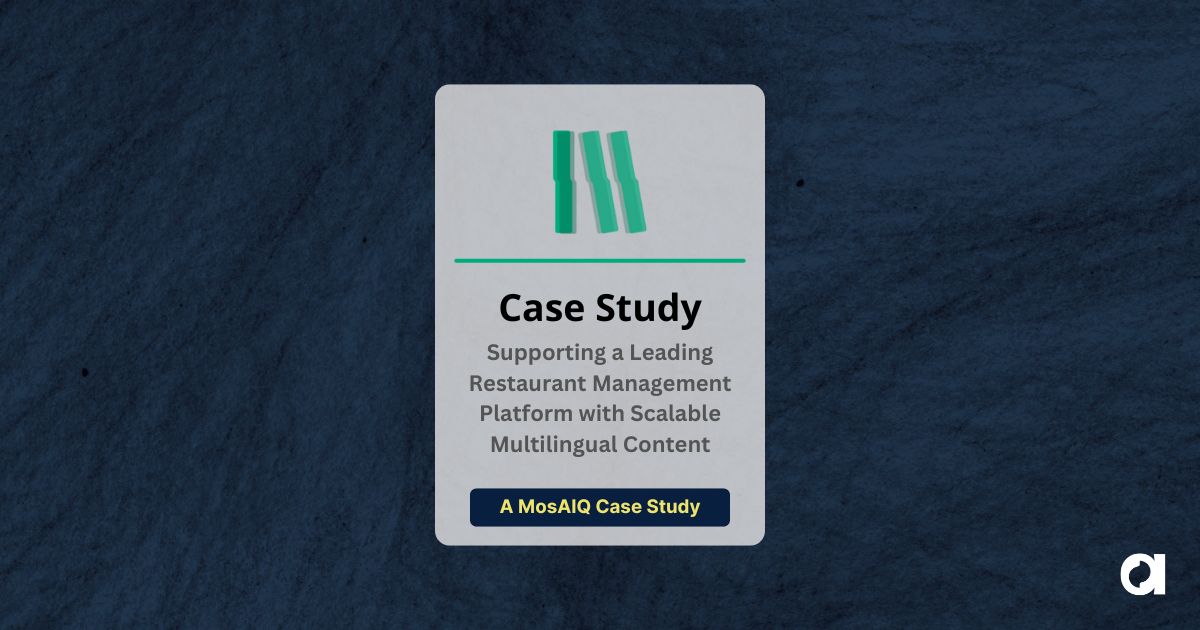Everybody’s talking about AI, but for localization leaders, the real question isn’t what are you doing with AI, but are you ready for it? In this short video, Stephanie Harris-Yee walks through the 11 key questions every organization should ask before bringing AI into their translation workflows.
From content preparation to risk management, the discussion highlights where teams need strong foundations and what gaps could derail results. If you’ve been asked to “do something with AI” but aren’t sure where to start, this episode helps you evaluate your readiness and take practical steps forward.
Key topics covered:
- Why content consistency and structured inputs matter for AI success,
- How outdated translation memories and source content can weaken outputs,
- The role of tools and QA processes in supporting AI-driven workflows,
- Key questions around risk, accountability, and data transparency,
- Building feedback loops that actually improve future outputs,
- How to spot gaps in your workflows before introducing AI,
- Free resources to assess AI maturity and readiness.
Watch the full video to see if your organization is truly ready to put AI into action.
Everybody’s talking about AI, and if you lead a localization team, chances are you’ve been asked what your team is doing with it. But the better question is whether your team is actually ready for AI. Hi, I’m Stephanie from Argos Multilingual Here to bring you quick answers to your translation questions.
Today’s topic is, is my organization ready to start using AI? We put together 11 questions to help you figure this out. Let’s start with the foundation, your content. The quality of your AI output depends on the content you use to train it. So it’s important to start with a strong foundation. The first questions to ask yourself are, is your content consistent, structured, and written for reuse?
And two, can it be understood without internal context or brand shorthand? And if your translation memories are outdated or your source content is inconsistent, these issues will carry through into your output. Before you introduce AI into any workflow, start by cleaning up your assets. Review what’s already there.
Fix misalignments and remove the noise. That work will give you a baseline you can trust. Whether you’re creating custom MT engine or using AI for QA, generating multilingual content, any of those. Next, ask yourself, can your tools support AI workflows? Do you have a process for reviewing AI outputs? And is your QA setup built to handle volume and variation?
If you’re planning to use AI, your systems need to accept the output route it for review and store the edits. You also need to make space for human post editing and running QA checks. If this kind of feedback loop isn’t in place, you may not get the full benefit of using AI for automation.
It is a good idea to look at your process. Be sure these steps are included before considering AI. When it comes to risk and accountability, ask yourself, do you know what data your AI tools were trained on? Are your prompts protected as confidential? Can you trace how the output was generated? Even if you didn’t build the model, you are still responsible for the results – that matters for every brand.
In regulated industries, it’s often a legal requirement. You may need to prove where your data came from, how it was reviewed, and how user data was handled. So before using any AI tool, check how it processes input. What training data it uses and whether it supports attribution and audits. If your goal is optimization, ask yourself, are you using real examples to guide the AI output?
Does your team know what good output looks like and are reviewer edits being tracked and used to improve future results. Getting reliable output from AI depends on the quality of your inputs.
Use examples that match your current tone, terminology and formatting. Skip anything outdated or inconsistent. What happens after is also important. So if your reviewers are fixing the same issue over and over, that’s your signal. Your feedback loop is broken. Make sure edits are reviewed, stored and reused to improve the next round of output.
When everyone understands what quality looks like and the system is trained on examples that match it, that helps you make better use of your team’s time. If these 11 questions were hard to answer, don’t worry. You’re just seeing the parts of the process that AI will put a little pressure on first. They point to the parts of your workflow that will affect whether AI will help or create more work.
That might include how you prepare inputs, how you define quality, or how you reuse edits Once you have the answers to these questions, you are in a great place to start preparing for AI. We have a couple of free resources that can help you identify your strengths, spot any gaps, and find out what to do next. First, our AI cheat sheet for localization managers. It offers important questions when considering adding AI to your workflows and our AI maturity model assessment can help you evaluate where you are today and how to get to the next level.
Both are free to download from our website and contain quick, practical advice. If you have questions about adding AI into your localization program, feel free to get in touch or learn more at argosmultilingual.com. Until next time.
 Argos Multilingual
4 min. read
Argos Multilingual
4 min. read
Here at Argos, we think a lot about how localization works. And we think just as much about how it can work better for you. We cover a lot of topics: strategy, system design, and the day-to-day details that keep localization teams moving. But sometimes the clearest way to explain something is to show it. […]

 Argos Multilingual
15 min. read
Argos Multilingual
15 min. read
Having an idea for AI transformation is one thing, turning it into a concrete, successful initiative is another challenge entirely. In this episode of Field Notes, Stephanie Harris-Yee speaks with Erik Vogt to uncover why many AI projects stall before launch, and how leaders can transform broad ambitions into measurable outcomes. Erik shares practical steps […]











